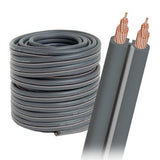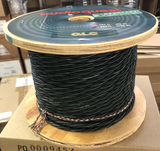AudioQuest Rocket 11 Raw Bulk Speaker Cable
Need a length not listed? Email HCMAudio@yahoo.com for pricing.
NOTE: A bundle is a single cut length of Rocket 11 cable.
ROCKET 11
- Ideal for Full-Range and for Single-BiWire
- Semi-Solid True-Concentric Conductors
- Long-Grain Low-Distortion Copper (LGC)
- 13 Gauge AWG
- Direction Controlled for Optimum Noise-Dissipation
Rockets 11 and 22 use Semi-Solid True-Concentric Conductors
for the rst time. AQ has been bragging about
the tremendous advantages of Concentric conductors for
years. In addition to the superior Long-Grain Copper used
in G2, X2, Q2 and the SLiP cables, and controlling directionality
— the concentric arrangement of the strands is why
these cables sound so clearly superior to other seemingly
similar cables.
“True-Concentric” is an industry standard term for when
each layer of strands in a concentric conductor is spiraled
in the opposite direction from the layer below, eliminating
the lines of contact between the layers, and increasing
contact pressure at the points of contact. The downside is
much more machine time and higher cost – the upside is
better sound you can hear.
Rocket 11 uses AudioQuest’s long-proven Long-Grain
Copper (LGC), while the slightly larger conductors in
Rocket 22 use an extremely eective blend of LGC and
Perfect-Surface Copper (PSC).
Skin-eect causes the sonic signature of a concentric
conductor to be almost entirely the signature of the metal
used for the outermost layer. True-Concentric construction
signicantly furthers this benecial eect by dramatically
increasing layer autonomy.
Preparing Rocket 11 and 22 for Full-Range is simple –
there is no braid to cut back and dress, no breakouts, no
legs or pants – and of course the cables are CL3 and FT4
certied.
Strip the PVC jacket and inner insulation, put the 2 red
conductors together, put the 2 black conductors together,
insert in the amp’s and speaker’s connectors, and play
music. Or, better yet, insert the bare ends into AQ SureGrip
100 Series or 300 Series Banana Plugs or Spade Lugs.
Preparing Rockets 11 and 22 for BiWiring is as quick and
easy as for Full-Range – at the “amplier” end put the two
red conductors together and the two black conductors
together as with Full-Range (see above ). At the “speaker”
end use one red conductor for positive treble, one black
conductor for negative treble, one red conductor for positive
bass and one black conductor for negative bass.









